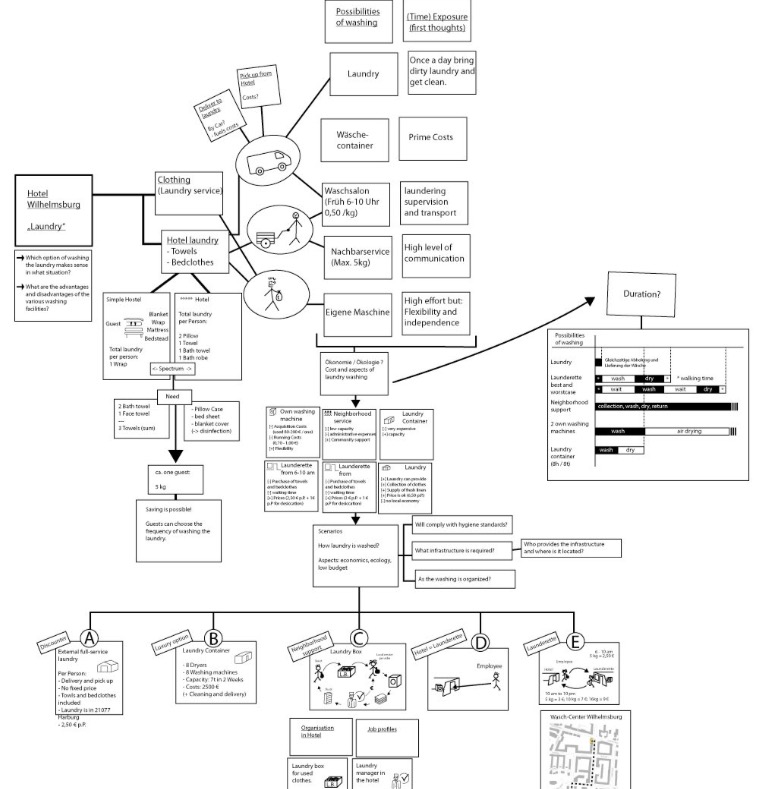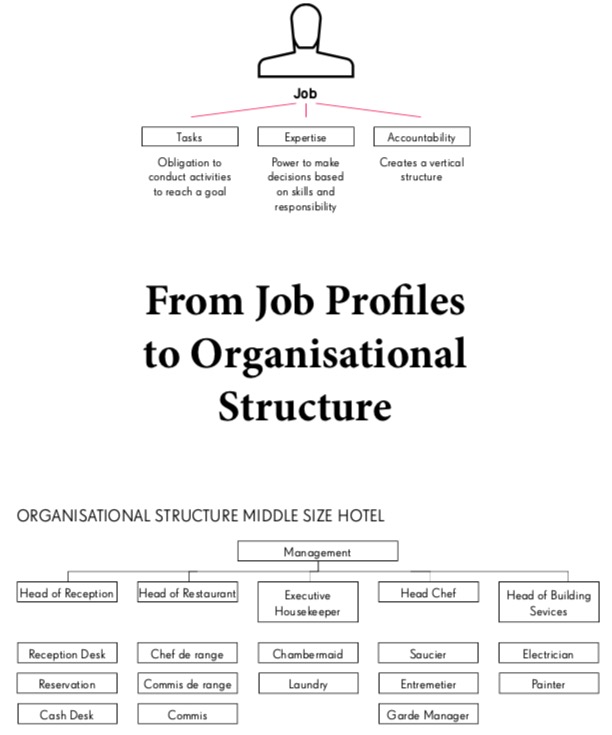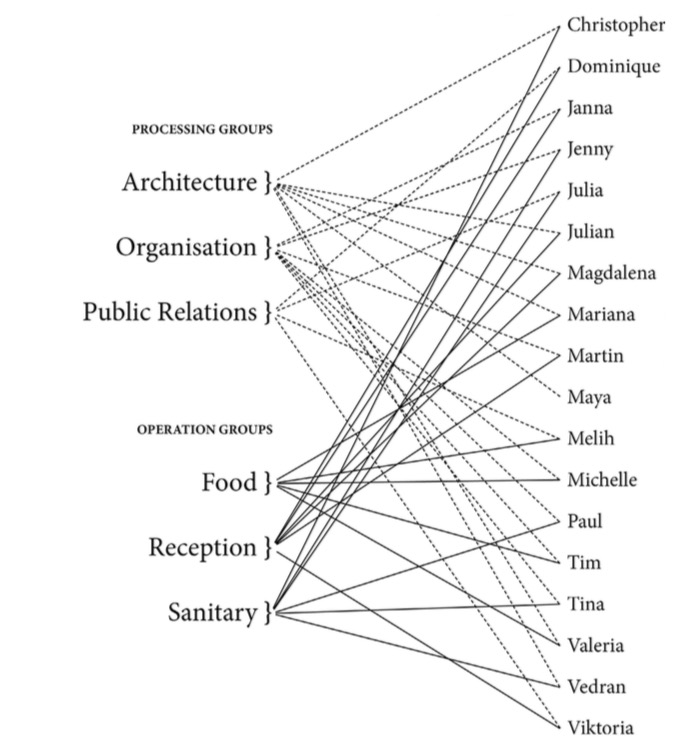Organisation Processes
On the following pages the various stages and focal points of the development of organisational processes are presented. The development of organisational structures was an important theme throughout the project. The challenge was to be able to think in other economic sectors and disciplines to find out what it means to run a hotel.
How does a group of people who do not know each other organise themselves?
The project started directly with an experiment. The project group was given the task to sleep one night outside at the University of Neighborhoods. There have been two rules: The university building was not to be entered, and only a limited amount of money was allowed to be spent. How to do that? First, the group set up an agenda to overview what needs to be organised and put it into tasks. Then they focused on the strengths of each group member. Questions came up like: "Who's familiar with the site? "or some took on tasks due to special abilities. In the end, five groups emerged who were responsible for different duties. Strengths and weaknesses are not always due only to personal characteristics or skills. For example, many people had recently moved to Hamburg and did not have many things, such as sleeping bags etc. The strength of Hamburg people was that they could compensate for their weakness because they could bring two sleeping bags.

First experience in practice as the planned organisation meets reality

Organization of Dinner No. 1
At the Wednesday dinners, the group's duties and responsibilities were distributed to smaller groups. Every week, there was a different group that was responsible for the organisation of the evening. At the first wednesdays dinner, the other group took care of tasks related to the evening, like documentation, bar service, reception. Later in the project, one group took over all the evening duties and other groups worked on the project. A unique feature within the organisational structure was the agents that brought us together with many different actors we would otherwise never have reached. To find staff, such as cooks, musicians or kitchen assistants, or cooperation partners from Wilhelmsburg was the most challenging task in the organisation of the Wednesday Dinners. At a certain point, we built a network of reliable supporters. It has been found that direct contact is critical.

How the situation came about: Actors of a constructed situation respective to dinner...
The Food Group had the idea to initiate a cooking session within the project group and those at the UdN anyway. Everyone should bring a few ingredients, from which an impromptu dish should be cooked. In practice, it turned out different. At the same time, our artist-curator Jan Holtmann spoke with another group. He had a bigger idea: to open the restaurant of the hotel immediatley. In this situation, Jan was the director, the person who initiated the overall concept. And Arne Wortman, one of our agents, already had contacts for us, whom we could ask to cook. The group who spoke with Jan and Arne now had a job – they had to organise the evening and distribute tasks to be prepared for the evening. At this point, they took on the roles of the director for the evening. They were responsible for their decisions, either hire a chef, find the right dish or equip the restaurant. The other groups that took over other tasks and had thus become direct contributors in the situation. Another actor was the guests who did not participate in the organisation process. But only with their engagement, the situation was possible. 1

Non-organised situations in the OPEN KITCHEN
Fear and loathing in the kitchen... I think at some points we saw ourselves as regulators, who have decision-making power or whose job it was to make the right decisions to achieve the best possible result for the evening. The analysis on the previous page describes it as a director, a more familiar terminology would be to explain the role of a regulator.
For example, during the preparation and organisation of one dinner, we feard a conflict concerning the chef cook and the kitchen helpers. Because we asked a Turkish lady to cook for us and at the same time a faithful companion of the project asked us...
B.: Should I come early and cook?
We then discussed for various reasons whether the combination could work or not...
T.: B. asks if he should come earlier to cook. What should we tell him? Can he come to help? Do you think he and the Turkish Lady are a right combination? Can it work?
One of the group members pointed out that...
M.: Turkish women generally do not like any other people in their kitchen. We already managed the menu; what will he cook? And please ask him not to drink alcohol around her. Please do not put her life in Danger!
Then we tried to consider how it might work.
M.: Hmm… I don't know…. I'm not sure if he is familiar with the Turkish food and can handle it to be an assistant. But he will come anyway so let's make the best out of it :) We can try to let them work together.
At the end, B. took part in the cooking session, and Jörg A. appeared unexpectedly and helped with the cooking. There was then a pleasant unexpected situation. And we had a delicious meal.

Working on scenarios to expose organisational structures
At various points, we tried to determine the appropriate organisational structure by working out different scenarios. Apparently, we were not able to come to an organisational structure like that. The development and establishment of organisational structures requires continuous feedback with the current situation. That means, only through constant testing and readjusting organisational structures can establish within the ongoing process.
The work on scenarios has helped to get a feel for what it means to operate a hotel. The artwork below shows a graphical derivation of a scenario that addresses the washing of laundry of the hotel. It has also identified knowledge gaps, which certainly play a role in the organisation of a hotel.

Conventionally, job profiles are defined to find workers to fill a particular position and perform a specific job. Would it not make more sense if workers themselves create their work field, according to their interests and abilities? One group was working on scenarios for different job profiles, who do not emerge from a fictional organisation structure and describe a specific job. There is a search for appropriate skills and knowledge that an employee should bring. According to knowledge and skills, different tasks can then be performed by one person. This means that it is created by the employee's profile, what form the hotel's organisational structure will take.

Working in a multi-structured organisation structure
Already in the project, students were divided into and working in different thematic groups. So concerning the job profile, we had already tested a model for a multidimensional job. In our case, the working groups organised Wednesday evenings and worked on developing the hotel components (Food, Reception, Sanitary). At the same time, a second group formation focused on architecture, organisation and public relations. These groups have formed mainly based on interests and special skills.

The focused Hotel structure and a critical comment
To legalise the doings of the project, which had already stretched far beyond the boundaries of a student Project, the organisation group worked on a structure that should meet the hotel's particular situation. Therefore, we designed a rather complex organisational structure, which we repeatedly extended, adapted and modified. The difficulty was to develop an organisational structure that, despite the limited financial resources or because of it, excludes a private individual liability. This task seemed almost not to be solvable. A solution was eventually to set up a caucus of representatives within the organisational structure who can assess risks due to their experience and avert it. This structure existed until recently, mostly on paper. In this case, it may be the same difficulty as in the overall development of an organisational structure in the project. Here first, a structure has been worked to perfection without testing it directly in the concrete situation. At the end, the structure was so complex and huge that a translation in the current situation would have been difficult because it would only work if all positions would be filled.

- in relation to the text "Vorbereitende Probleme zur Konstruktion einer Situation "by Raoul Vaneigem of the year 1990. In: Der große Schlaf und seine Kunden. Situationistische Texte zur Kunst, Hamburg, S. 41-45. ↩